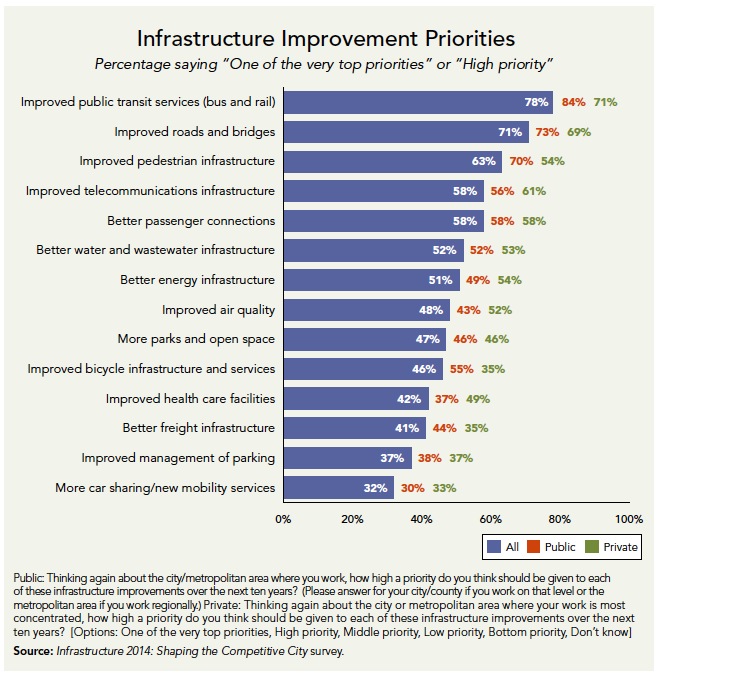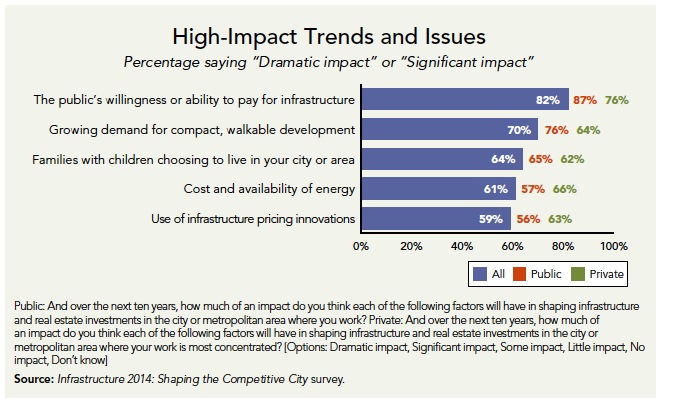URBAN LAND INSTITUTE
Executive Summary
 HOW DO REAL ESTATE DEVELOPERS AND INVESTORS—who could pursue opportunities regionally, nationally, or internationally—think about infrastructure? How do city leaders use infrastructure investments to position their cities for real estate investment and economic development? What role does infrastructure play relative to other economic development strategies? And are public and private perceptions and priorities aligned—or do they diverge, and in what ways?
HOW DO REAL ESTATE DEVELOPERS AND INVESTORS—who could pursue opportunities regionally, nationally, or internationally—think about infrastructure? How do city leaders use infrastructure investments to position their cities for real estate investment and economic development? What role does infrastructure play relative to other economic development strategies? And are public and private perceptions and priorities aligned—or do they diverge, and in what ways?
These were the central questions for Infrastructure 2014: Shaping the Competitive City, the eighth in an annual series of reports examining infrastructure trends and issues by ULI and EY.
To provide answers, researchers for Infrastructure 2014 crafted a series of survey questions and asked high-level public officials and private real estate leaders to weigh in. Nearly 250 public sector leaders in local and regional government and over 200 senior-level private developers, investors, and real estate advisers responded to the survey. About 86 percent of survey respondents were based in the United States, with the balance located in countries across the globe.
Nearly every city aspires to grow, and high-quality infrastructure—infrastructure that is well maintained, reliable, safe, resilient, and customer friendly—contributes to well-functioning, growth-primed cities—cities that attract new residents and retain existing ones.
Infrastructure—the physical facilities and systems that support economic activity—is often seen as a driver of real estate and development, especially by those who are in the business of providing it. But do the people actually building and investing in real estate agree? The Infrastructure 2014 survey tells us “yes”—and a number of other interesting things as well.
On many of the questions asked, there was strong convergence between the public and private sector respondents, and between U.S. and global ones. The survey provides a means for mutual learning and dialogue that can help advance the conversation about the role that infrastructure plays in shaping and promoting growth, infrastructure priorities, and opportunities to improve current practice.
Finding 1 – Top Drivers of Real Estate: Infrastructure, Consumer Demand
Infrastructure quality emerged in our survey as the top factor driving where real estate development happens, leading the list of eight possible forces shaping real estate investment.
Eighty-eight percent of survey respondents rated infrastructure quality as a top or very important consideration when determining where real estate investments are made. Infrastructure came out highest for public leaders (91 percent) and second to the top for private leaders (86 percent).
Consumer demand was the top driver for the private sector, with 90 percent of private leaders ranking it a top consideration or very important. A skilled workforce was more likely to be seen as important by the public sector (89 percent) than the private sector (64 percent).
Government services—regulations, tax structure, and quality—fell in the middle of the group of influencing factors for both public and private respondents. However, the private sector saw tax structure as less important than public leaders did, and government quality as more important.
The survey affirms the importance of infrastructure in metropolitan economic development strategies.
Download full version (PDF): Infrastructure 2014
About Urban Land Institute
www.uli.org
“The mission of the Urban Land Institute (ULI) is to provide leadership in the responsible use of land and in creating and sustaining thriving communities worldwide. Founded in 1936, the institute now has more than 40,000 members worldwide representing the entire spectrum of land use and real estate development disciplines, working in private enterprise and public service.”
Tags: ULI, Urban land Institute








 RSS Feed
RSS Feed